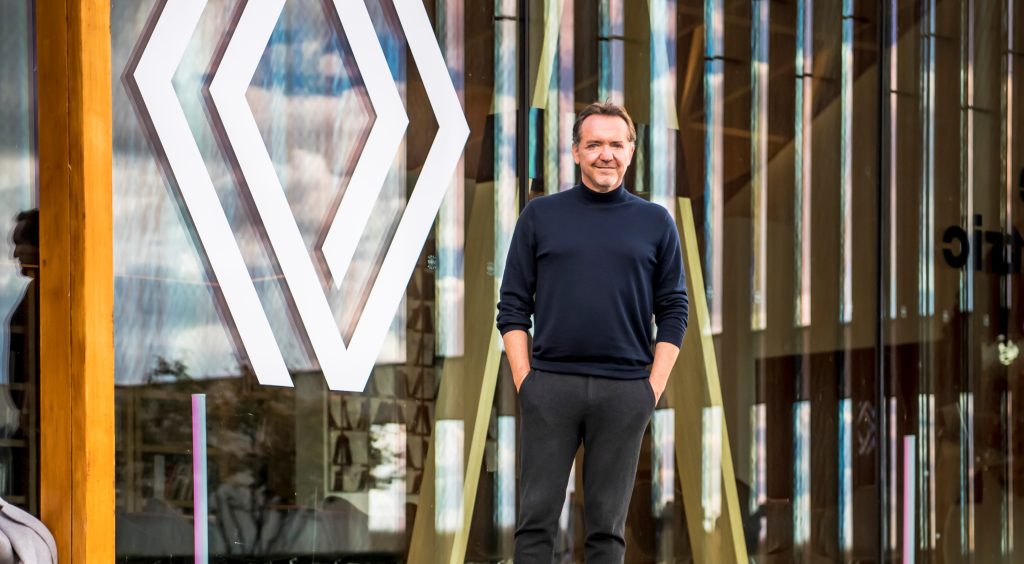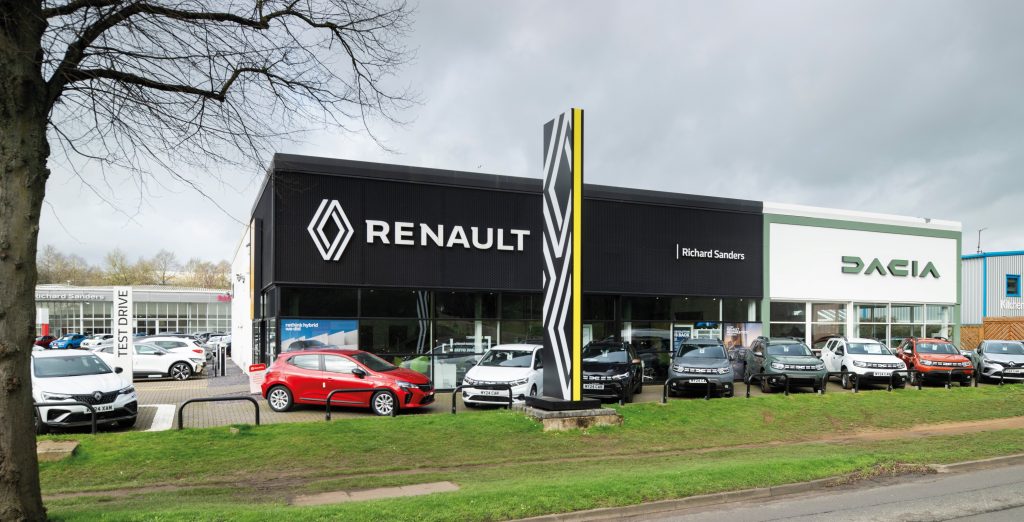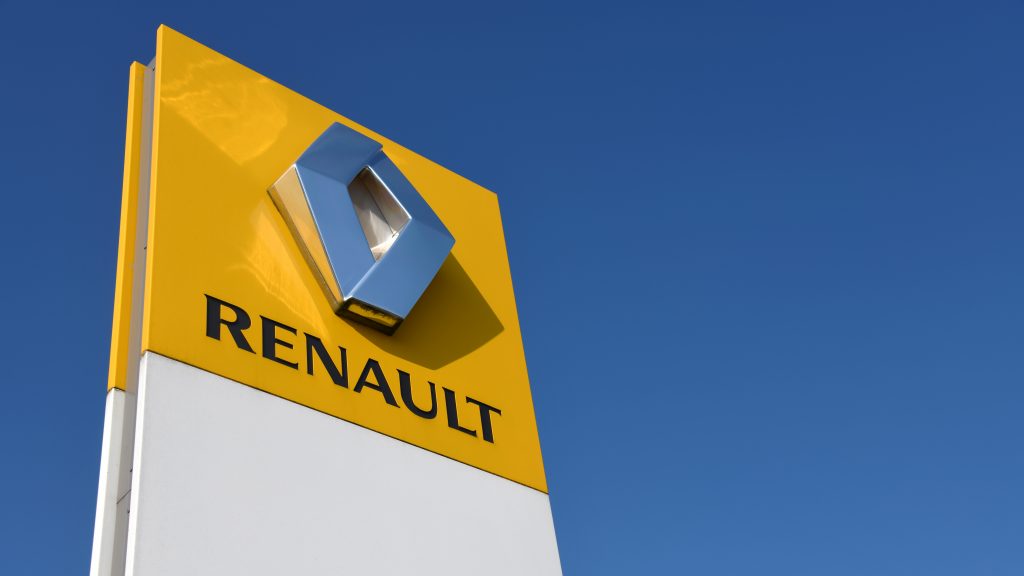
By Guy Bird
After a bumpy few years, Renault Group UK MD Guillaume Sicard explains how the French marque and Romanian sister brand Dacia can continue to improve, through new exciting products, consistency and respect for the dealer network
He might be more of a Daft Punk fan than a Jean Michel-Jarre advocate – despite respecting the latter’s work in creating the sounds for Renault’s new electric cars – but there’s nothing silly about Guillaume Sicard’s dealer approach since his first official day as Renault Group’s UK md on 1st January 2022.
“It was a bit rocky two or three years ago,” he concedes, in heavily French-accented, but highly-fluent English. “In the latest NDFA Dealer Attitude survey Renault was 17th overall and Dacia ninth. Even though that’s probably one of our best results in the last five years, let’s see where the next survey places us.”
In the previous survey, Renault placed 20th and Dacia 13th, so dealer relations would appear to be moving in the right direction. That goes for sales too. Compare 2022 to 2023 and while Dacia’s gently increased (from 27,315 to 28,873), the Renault brand made a huge jump (from 46,506 to 70,327). More broadly in 2023, Renault Group’s total UK car and LCV sales numbered 99,494, with the top-selling model the Renault Trafic van (16,984), ahead of Clio (12,898), Captur (12,708) and the Dacia Duster (10,085).
Sicard’s tone is measured, but also quietly confident. It’s just weeks after the 2024 Geneva Motor Show, where the Renault 5 received a positive public response and the Scenic was crowned European Car of the Year. But there’s more to it than that.
“The way we manage the relationship with the dealer is number one, to make sure they have a vision,” he says. “We’ve been helped by the ‘Renaulution’ of [CEO] Luca de Meo, because it gives a clear and pragmatic visibility of where we want to be, and the kind of line-up and focus we are going to have.
The second thing, was to make sure we were stable. Dealers hate it when for half the year you do one thing and then in another three months you do something else. What’s important is to have a sense of simplicity and that is what we have promoted with the team over the last two years.
“The third point is respect. There can sometimes be a bit of a battle between us and the dealers. So what we want to make sure is that it’s a respectful relationship. I was a dealer principal for three years in Le Mans 20 years ago, so I always put myself in the shoes of a dealer when there is a message to give, or if something is problematic. I think how I would react as a dealer. And they need to make money – it’s a necessary condition – and at the same level as other global brands.”
Given his previous role was chief operations officer for Renault China, did he learn anything there that might help combat the onslaught of well-priced electrified cars from Chinese domestic brands coming to the UK? “Good product, quality and cost is not enough,” he says. “These were values I was used to, but one I wasn’t and learnt in China was ‘speed’. Even though things are not fully perfect, they just ‘go’, and by iteration fix the issues once they’re busy implementing. The Western way – to make sure everything is ready and then implement – is very costly and slow.”
 But with its 125-year-plus history, Renault can play a trump card the new Chinese brands can’t: heritage. The retro-inspired 5 Prototype unveiled in January 2021 – as most global citizens were still locked down by their governments trying to halt the spread of the COVID-19 virus – was perhaps just the nostalgic tonic needed by those with happy memories of the freedom afforded by previous generations of the 5 growing up in the 1970s and 80s. With some 50,000 orders for the production version of the 5 already placed across Europe, Renault’s pitch would seem to be working. Pricing from circa £25,000 for the larger 248-mile range 52kWh battery – with UK deliveries from early 2025 – should help make the brand competitive in a whole new EV segment too (one notch below the current Zoe on price and size).
But with its 125-year-plus history, Renault can play a trump card the new Chinese brands can’t: heritage. The retro-inspired 5 Prototype unveiled in January 2021 – as most global citizens were still locked down by their governments trying to halt the spread of the COVID-19 virus – was perhaps just the nostalgic tonic needed by those with happy memories of the freedom afforded by previous generations of the 5 growing up in the 1970s and 80s. With some 50,000 orders for the production version of the 5 already placed across Europe, Renault’s pitch would seem to be working. Pricing from circa £25,000 for the larger 248-mile range 52kWh battery – with UK deliveries from early 2025 – should help make the brand competitive in a whole new EV segment too (one notch below the current Zoe on price and size).
As will the Dacia Spring Mk2, with prices from £14,995, for a 137-mile range 26.8 kWh battery and 45 or 65hp powertrains, making it the cheapest EV on sale in the UK. First deliveries are expected in October 2024 and these two models – alongside the new Scenic already on sale – will be key. Not only to the Group’s sales aspirations but also to meet its 22% Zero Emission Vehicle (ZEV) Mandate target for 2024. Sicard says he doesn’t plan to pay any ZEV mandate-related fines for failing to reach that percentage, nor buy credits off other brands, but admits it will be hard: “The market is tricky. Today we’re probably at 16% [EV penetration]. Last year it was 16.5% and the year before 16.4%, which is amazing as the [EV market] offer has tripled over the last two years and prices are more competitive. But sales – in terms of mix – are stable. With the Spring and 5 we offer something different and the Scenic is probably one of the best family cars today that [just] happens to be electric. At a dealer level we have to really put the car first, then reassure about the electrification.”
By summer these products will be joined by the Renault Symbioz C-segment and Rafale mid-size 4.7-metre long crossover hybrids, plus the improved Dacia Duster Mk3 (also now hybrid), with the Alpine A290 to follow in late 2024 (as a go-faster sister version of the Renault 5 EV). Sicard reiterates that Renault will stay with a traditional “non-agency model,” while still tracking the importance of digital channels and has already made a minor toe-dip into the subscription model. He reckons the latter market route only equates to about 30-50 units a month currently, but says it’s still a useful learning tool, in terms of customers’ evolving digital interactions.
So where might new future dealer profitability options come from? “I think the opportunity is probably within the overall electric eco system that we need to develop,” Sicard muses, “in home and smart charging, charge passes, relationships with energy suppliers and fast-charging on location at the dealership. Then after that, we keep increasing the level of service, so we can organise a high quality level of assistance to manage, maintain or deliver the car.”
 As long as customers can reach a dealer within 45 minutes he’s happy to consider fewer dealers with higher profit potential within an unspecified future timeframe too. Of the current 143-strong network, all bar three are dual Renault and Dacia franchises, with 16 of those sites also representing the sporty but currently tiny Alpine brand. “I’m not against reducing the footprint of the network, but it doesn’t mean I don’t want dealers,” he clarifies. “I’m just thinking about efficiency and how our customers are behaving. I think 110 [retailers] is a possibility that could work, to deliver the best quality service to our customers and optimise the profitability of our partners.”
As long as customers can reach a dealer within 45 minutes he’s happy to consider fewer dealers with higher profit potential within an unspecified future timeframe too. Of the current 143-strong network, all bar three are dual Renault and Dacia franchises, with 16 of those sites also representing the sporty but currently tiny Alpine brand. “I’m not against reducing the footprint of the network, but it doesn’t mean I don’t want dealers,” he clarifies. “I’m just thinking about efficiency and how our customers are behaving. I think 110 [retailers] is a possibility that could work, to deliver the best quality service to our customers and optimise the profitability of our partners.”
Guy Bird is a freelance writer and a regular contributor to Motor Trader and the Motor Trader Industry Awards
 Motor Trader The award-winning and longest running UK magazine for car retailing professionals. Your first stop for News, Jobs and Reports for the motor industry.
Motor Trader The award-winning and longest running UK magazine for car retailing professionals. Your first stop for News, Jobs and Reports for the motor industry.